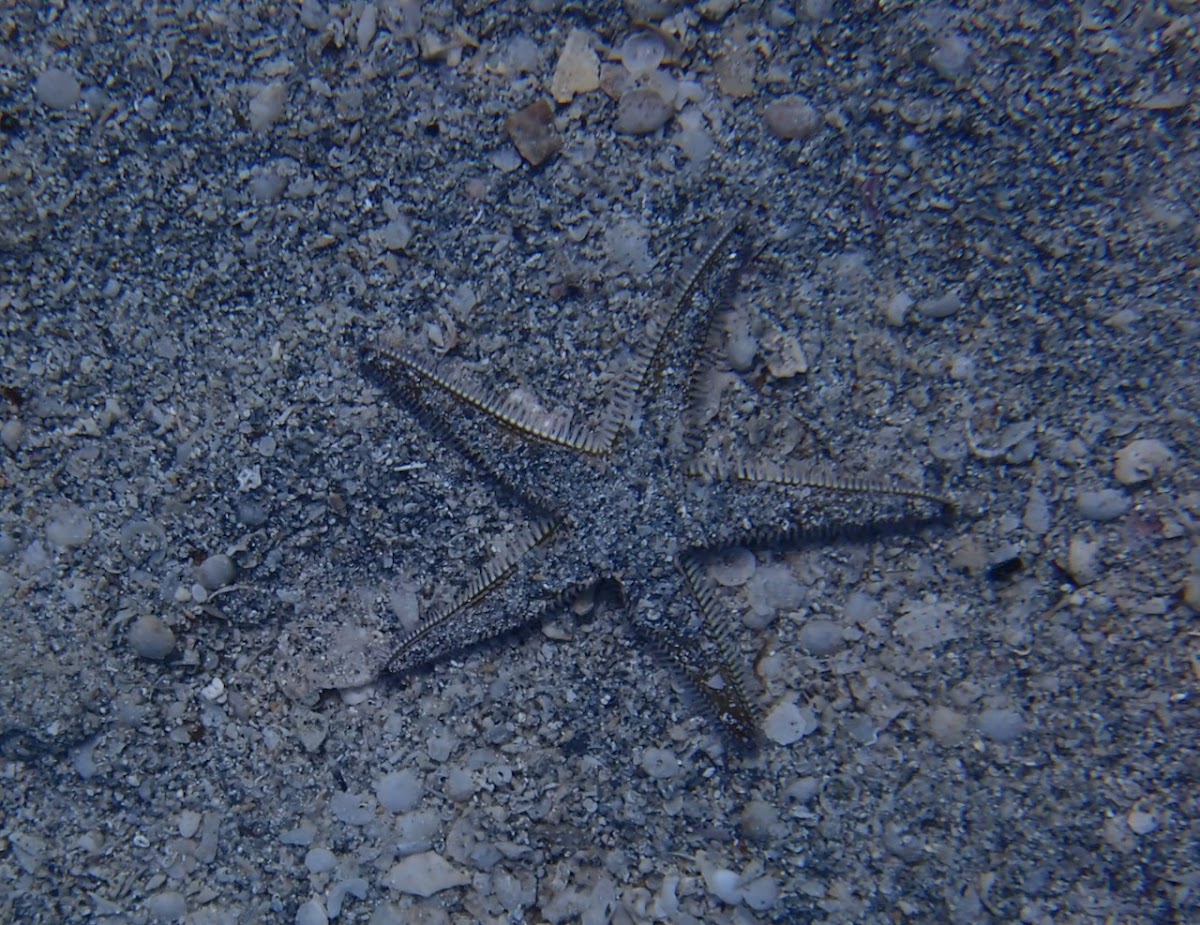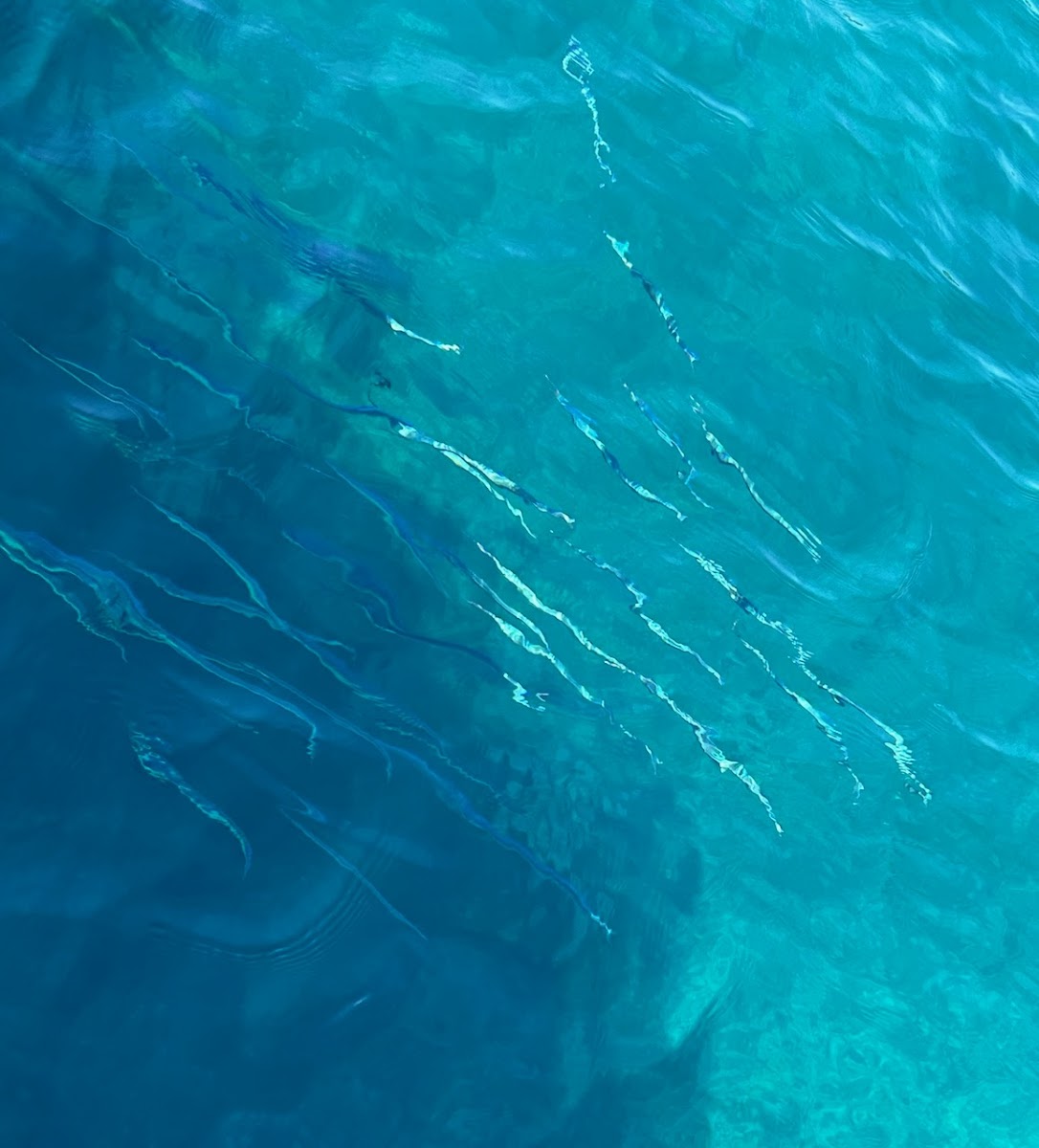In the afternoon on Thursday we sailed to island Krk to Punat lagoon to pick up some more friends. We spent the night there, and sailed to Rab again on Friday morning. There was still some NW wind blowing, but not much. The most exciting thing was a group of dolphins, some dozen of them, swimming by. Unfortunately I didn't have my camera at hand.
On Rab we anchored in Uvala Planka, one of my favourite bays for snorkelling. I went into the water straight away and it was again great.
This is without a doubt a big trophy of this year, I found it under a rock on East side of the bay. I dove down several times and still the photos weren't as great as I hoped for. It is a Spinous squat lobster or Pisani skakač (Galathea stringosa).
Here is another Marbled rock crab or Marogasta rakovica (Pachygrapsus marmoratus), just couldn't resist the pretty face.
Uvala Planka is full of these beauties, the Sea strawberries or Rožnatih plaščarjev (Sindyum elegans or Aplidium elegans), this is probably where I saw them for the first time quite some years ago and was amazed that such colourful things exist in Adriatic sea.
But there were other Tunicates there as well, not less pretty. These are the Colonial tunicate or Spužvasti plaščarji (Didemnum spp.)
These two are both members of the seabreams family - the bigger Annular seabream or Špar (Diplodus annularis) and the smaller Commno two-banded seabream or Fratrc (Diplodus vulgaris). In every bay in Rab where we anchored there was a big school of Annular seabreams under our boat. They were grateful for all the bread crumbs and vegetable rests that we threw into the water.
Finnaly there was also plenty of small fish in Planka, this one is a Zvonimir's blenny or Jelenoroga babica (Parablennius zvonimiri).I think this is a Pink bush algae or Kosmata alga (Wrangelia penicillata).
I saw several very large schools of Mediterranean sand smelts or Velikih gavunov (Atherina hepsetus).
And finally one of the fan worms - the Red tube worm or Pisani pokrovčkar (Serpula vermicularis).
The Pig-tooth coral or Scarlet coral or Kamnito nakovalce (Balanophyllia europaea) doesn't look like much during the day, it only extends its polyps at night. I find that Slovene name is most suitable for it, translated it would be Small stone anvil.
This was a first for me - these are Greater amberjack or Gofi (Seriola dumerili), I recognised them by the darker stripe across the eye and small fins. They probably came into the bay to hunt for Sea needles.
There were also plenty of birds in the bay, especially the ones that feed on fish. The European shags or Vranjeki (Phalacrocorax aristotelis) were drying their feathers on the rocks after they were diving for gobies. This one was a bit confused by me swimming up to him but stayed put...
...and this one decided I came too close and moved across the bay.
These weren't the only birds we saw there, in the afternoon while swimming I saw a beautiful Kinfisher or Vodomca (alcedo atthis), he was fishing from a rock at the edge of the bay. I swam in his direction very slowly and he even let me come quite close. I wish I had my camera with me!
These pretty flowers are relatives of corals, they are the Yellow cluster anemone or Rumeni zoantar (Parazoanthus axinellae). I found them in huge numbers in a small cave in relatively shallow water, usually they live in deeper water and always in very shady areas.This was one of my attempts at using the microscope feature of my camera and I was surprised that it worked, usually there is a lot of good light necessary for a decent photo. Here you can also see the polyps on Hydroids.
There is plenty of interesting stuff on this photo, there is an Orange ray sponge or Spužva žilavka (Spirastrella cunctatrix) with translucent osculas (the openings through which the filtered water is expelled) above, then there is the the Kidney sponge or Ledvičasta spužva (Chondrosia reniformis) in the middle and in the bottom there is the green algae Codium or Zgrbančeni kodij (Codiun effusum). And I think there is even a colony of tunicates just left of the Kidney sponge - maybe a Sponge sea squirt or Prosojni prevlekar (Diplosoma spongioforme) and next to it above the Codium there is also a Sea strawberry or Rožnati plaščar (Sindyum elegans or Aplidium elegans).
This photo didn't earn it's appearance in this post because of the Sea strawberry or Rožnatega plaščara (Sindyum elegans or Aplidium elegans), but because of the nudibranch Hope's Elysia or Pisanička (Thurdilla hopei) just left above the sea squirt. I discovered it only after analysing the photo on my computer, and I found some more on other photos where I was photographing other things. It is not a good photo of it, but it is the only one where the nudibranch is even recognisable. It is probably due to the poor light that I haven't noticed any while snorkelling.
Next day, on Saturday, we sailed to town of Rab and filled Heron's fuel tank and bought some fresh bread. Then we sailed to Uvala Sveti Kristofor again. Shortly after anchoring I was in the water again. There were plenty of fish and interesting things to see.
This fellow is the Sharpsnout seabream or Pic (Diplodus puntazzo).
I love how pink the tentacles tips of this Snakelocks anemone or Voščene morske vetrnice (Anemonia viridis) are.
This is a green algae Green sea forks or Grmičasti kodij (Codium vermilara), here from the side ...
... and this is the same thing from the front. I didn't touch it, but it looks very fluffy.
Here is another Zvonimir's blenny or Jelenoroga babica (Parablennius zvonimiri), in a bit brighter colour than the one above.
There ware also the Mullets or Ciplji (Liza spp.) patrolling the bay.
The Sea lemon or Morska pomaranča (Tethya citrina) was exactly the same as a few days ago, but I think it deserves another photo here.
This is a Small triplefin blenny or Pritlikavi sprehajalček (Tripterygion melanurus), in Croatian Pjevčič patuljič and in Italian Peperoncino minore. It has such poetic names - translated Slovene name would be a Dwarf walker, Croatian name would mean Dwarf singer and Italian Little chilli pepper. Cute!
On Sunday afternoon we brought our friends back to Punat on Krk. We sailed off straight away and anchored in bay Meli on Cres at around 10 in the evening. I was surprised that there were already 4 sailboats anchored there.
I love how pink the tentacles tips of this Snakelocks anemone or Voščene morske vetrnice (Anemonia viridis) are.
This is a green algae Green sea forks or Grmičasti kodij (Codium vermilara), here from the side ...
... and this is the same thing from the front. I didn't touch it, but it looks very fluffy.
Here is another Zvonimir's blenny or Jelenoroga babica (Parablennius zvonimiri), in a bit brighter colour than the one above.
There ware also the Mullets or Ciplji (Liza spp.) patrolling the bay.
The Sea lemon or Morska pomaranča (Tethya citrina) was exactly the same as a few days ago, but I think it deserves another photo here.
This is a Small triplefin blenny or Pritlikavi sprehajalček (Tripterygion melanurus), in Croatian Pjevčič patuljič and in Italian Peperoncino minore. It has such poetic names - translated Slovene name would be a Dwarf walker, Croatian name would mean Dwarf singer and Italian Little chilli pepper. Cute!
On Sunday afternoon we brought our friends back to Punat on Krk. We sailed off straight away and anchored in bay Meli on Cres at around 10 in the evening. I was surprised that there were already 4 sailboats anchored there.
We had a peaceful night and sailed off in the morning after breakfast. We sailed by on Ćutin islands in front of bay Meli...
...and anchored in a bay at Male Orjule in the middle of the day, I decided I want to snorkel there.
Under the water I didn't see anything spectacular, just this big and fat Mullet or Ciplja (Liza spp.)...
.. and obligatory school of Annular seabreams or Šparov (Diplodus annularis) under our boat.
In the evening we returned to marina in Mali Lošinj and next day I returned home. Captain stayed on the boat for two more weeks.
.. and obligatory school of Annular seabreams or Šparov (Diplodus annularis) under our boat.
In the afternoon we sailed along the coast of Lošinj and anchored in bay Sunfarni for the night. And luckily we were alone again.
Next day I went snorkelling again, around midday, when the light is the best. It wasn't the best snorkelling ever, but I found lots of usual suspects. And I enjoyed every moment of it, knowing it is probably my last snorkelling for the year.
This may look like a green algae, but it's not - it is a Calothrix, a sort of Cyanobacteria, its Slovene name is Kalotriks (Calothrix spp.)
There were many Beadlet anemones or Rdeče morske vetrnice or Konjske vetrnice (Actinia equina) with its velvety red mantle.In the evening we returned to marina in Mali Lošinj and next day I returned home. Captain stayed on the boat for two more weeks.
I was so happy that we had such good weather and that water was still warm enough for snorkelling. And that I managed to make so many nice photos, although the light was really not the best.





























































